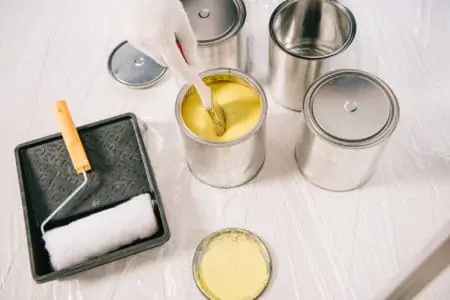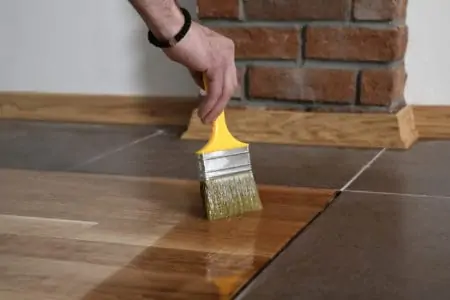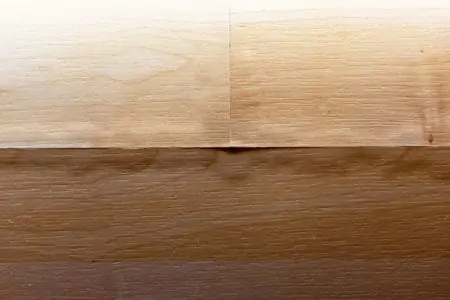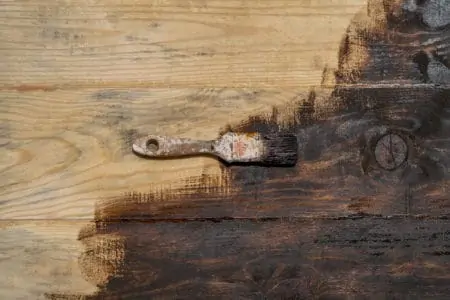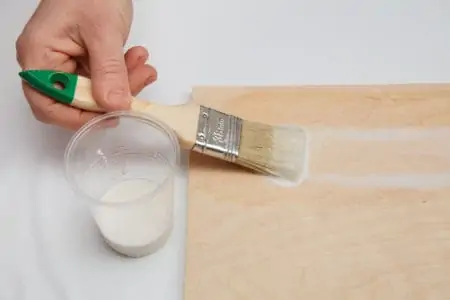Trying to decide what paint finish you want on your walls or furniture can be tricky. Two popular choices are satin and gloss paint, but what is the difference between them?
We look at satin vs. gloss paint, examining what makes them so different and which is best for your surfaces.
Key Takeaways
- Satin paint has a subtle sheen and is better for walls and ceilings, as it hides imperfections.
- Gloss paint is highly reflective and more durable, making it ideal for trim, baseboards, and high-traffic areas.
- Semi-gloss paint is a middle ground between satin and gloss, offering some reflective sheen and durability for furniture and cabinets.
- Choosing the right paint depends on the surface, room conditions, and desired appearance.
Satin vs. Gloss vs. Semi-Gloss
The simple answer to what makes these three paints different comes down to the finish. Satin has a softer sheen, while gloss reflects light, and semi-gloss is somewhere between the two.
Satin
The competition between satin vs. semi-gloss paint is close because they both have a softer sheen than gloss. However, satin paint reflects light more subtly.
Satin is an excellent choice for walls rather than trim or crown moldings because it covers blemishes and imperfections better.
Satin paint contains fewer binders, making it less dense. You get a better spread, and it moves easier from the brush to the wall.
Gloss
Gloss paint contains the highest number of binders and resins, forming a hard shell when it dries. This shell is highly reflective, so in darker spaces, it could help to brighten the room.
Crucial Point
Gloss is not suitable for walls and ceilings because it shows up every surface blemish. However, for trim, baseboards, and any other woodwork, it is the perfect paint. Gloss paints are typically oil-based, which makes them harder to clean after use.
Gloss paint is also resistant to moisture, making it suitable for kitchen and bathroom trim and baseboards. It also stands up well to vigorous scrubbing.
They are also bad for the environment because they contain VOCs (volatile organic compounds), which emit low-level ozone as the paint cures. You also need mineral spirits to wash the brushes clean, which is poison to the natural world.
Semi-Gloss
Semi-gloss paint is the perfect in-between paint. It still has a gloss-like finish but contains fewer binders and resins, making it more versatile. It will still show imperfections on walls and ceilings, but it reflects light in rooms like bathrooms.
The best use for semi-gloss paint is on furniture and kitchen cabinets. It still has that wipe-clean quality, but it has a more muted sheen.
Comparison Chart
| Features | Satin Paint | Gloss Paint | Semi-Gloss Paint |
| Sheen | Slight sheen | High sheen | Medium sheen |
| Appearance | Flat | Shiny | semi-shiny |
| Reflection | Minimal | High | Medium |
| Durability | Low durability | High durability | Medium durability |
| Cleaning | Wipeable | Vigorous wiping | Medium wiping |
| Price | $$ | $$$$ | $$$ |
| Uses | Walls and ceilings | Trim, woodwork, and furniture | Cabinets, trim, woodwork, furniture |
What Is Satin Paint?
Satin paint is an excellent option if you want all the qualities of matte paint and yet retain a slight reflective sheen. It contains fewer resins and binders, with the focus mainly on pigmentation.
So, you get a vast array of colors that coat easier because the paint is thinner.
It is wipeable with mild cleansing agents, and it gives a super smooth surface. It also dries faster than gloss, typically taking a couple of hours.
Keep In Mind
Satin is less durable than gloss, and it is tricky to apply touch-ups because when they dry, they stand out. Plus, satin paint lacks moisture resistance, so use it sparingly in bathrooms.
Best Uses
Satin paint doesn’t bounce light in the same way as gloss, making it better for walls because it hides imperfections. It is also easier to apply than gloss, so you get a better spread. This is because its primary function is to carry color rather than bind.
Satin paint works well in high-traffic areas and in rooms where the walls are likely to come into contact with hands, like children’s bedrooms. You can even thin it using water and use it as a spray paint for a smoother finish.
You should use satin paint in hallways, bedrooms, lounges, but they are not great in kitchens and bathrooms. Also, don’t try to paint your patio furniture in satin paint because it is typically intended for interior spaces only.
Pros
- Goes on easier than gloss.
- Hides imperfections.
- Fast-drying in a couple of hours.
- Gives a smoother surface.
- Good coverage.
- Easier to clean.
- Wipeable with mild cleansers.
Cons
- Less durable than gloss.
- Difficult to touch up.
- Lacks moisture resistance.
Best Satin Paints
This KILZ Tribute range of satin paints is low in VOCs and 100 percent acrylic-based. They come as a paint and primer in one, so you can skip the priming stage and get straight to painting.
It is scrubbable, has a low odor, making it more comfortable to use indoors, and you can choose from 100 colors.
Another favorite is this Majic Interior/Exterior satin, which can be used on exterior surfaces like patio furniture and sidings. It might not come with the same variety of color choices, but it is durable and scratch-resistant.
You can also paint it straight onto bare surfaces without priming. It coats aluminum, wood, glass, and just about any other material you can think of.
For protective qualities, try this Rust-Oleum Black Stops Rust paint. It has enamel as a key ingredient, so it dries to a more durable finish. While this example comes in black, other colors are available.
If you want to coat floors or paint on furniture, the formula resists chipping, flaking, and fading. It also has rust-resistant ingredients, so exterior metal surfaces are protected too.
What Is Semi-Gloss Paint?
Semi-gloss paint is somewhere in between satin and gloss. It still retains high resin and binder levels, but the sheen is more muted compared to gloss. It is wipeable, withstands high-traffic areas, and gives just enough reflection to brighten the room.
Take Note
Most semi-gloss paints are oil-based, which means that they contain VOCs and have strong odors. If you are painting on wood, make sure you ventilate the area.
You can use semi-gloss on walls in low-light areas, but it will still show up imperfections.
Best Uses
One of the best uses of semi-gloss paint is when painting kitchen cabinets. It offers all the protection of gloss without you being blinded by the light (yes, that was a Bruce Springsteen reference).
Semi-gloss also works on furniture because it resists chipping and can be wiped clean using detergent. If you have trim, baseboards, window, and door frames that need a fresh coat, semi-gloss is also a good choice to use.
Pros
- Durable for high-traffic areas.
- Withstands cleaning with detergent.
- Highly moisture-resistant.
- Reflects light to brighten rooms.
Cons
- Highlights imperfections.
- If applied incorrectly, it stands out.
- Not as durable as gloss paint.
Best Semi-Gloss Paints
This Rust-Oleum Painter’s Touch Semi-Gloss paint is an excellent product. It works indoors and out, covers 120 square feet, and is low in VOCs and odors.
It coats wood, plaster, masonry, and even unglazed ceramics, and dries to the touch in just 30 minutes.
Another option is this Diamond Brite Semi-Gloss Latex paint. It comes in 14 color options, covers wood, primed metal, drywall, and masonry, and is dirt and grease-resistant.
This is a dry hide paint, so when you lay down a layer, it starts out clear and then increases in color as it dries.
What Is Gloss Paint?
Gloss paint has the highest sheen of the lot. It is thicker because it contains higher levels of binders and resins. It works in the same way as varnish by drying to a hard shell on the material’s surface.
It is gloopy when you paint it on, so you are limited to a brush or roller, and the paint coats in thicker layers, taking longer to dry.
Most gloss paints are oil-based, so while it is the perfect paint for reflecting light, it is harmful to the environment. Gloss paint contains high levels of VOCs and gives off a strong odor. When painting inside, open windows and doors.
Keep In Mind
Water-based gloss paints are available, but the majority are solvent or oil-based, so check the label when you make your purchase.
Gloss paint is durable, resists stains, and is scrubbable. It resists chips and scratches, so it is ideal in high-traffic areas.
Best Uses
Gloss paint is your best option for painting trim, like door frames and baseboards, because it is so hard-wearing. You can also use it to paint cabinets and furniture, although it is not suitable for walls and ceilings. Its reflective quality shines a light on every blemish and dent on the surface.
Top Tip
If you have a dark space and need to maximize natural light, gloss paint is highly reflective to bounce light throughout the room.
Gloss paint is suitable for high-moisture rooms like kitchens and bathrooms because the hard shell forms a barrier against water; however, it is not ideal for use on kitchen counters and other food-prep surfaces like on tables.
Pros
- Highly durable.
- Resists moisture and humidity.
- Ideal for painting trim.
- Resist staining.
- Reflects light to brighten rooms.
Cons
- Not suitable for walls and ceilings.
- Highlights surface imperfections.
- Unsuitable for food prep areas.
- Oil-based paint is bad for the environment.
Best Gloss Paint
This Rust-Oleum Clear Gloss paint dries clear like a varnish. It is resistant to UV and never fades or yellows. It makes it ideal for exterior and interior surfaces. This paint is also water-based, so it is better for the environment and releases minimal VOCs as it dries.
This Krylon Lacquer Spray Paint Black Gloss is easy to apply and goes on super smooth. If you hate brush marks, this is the answer. Plus, when you are done, it is easy to store.
It is moisture-resistant and dries in 15 minutes, which is unusual for gloss paint.
Satin vs. Semi-Gloss vs. Gloss: Which One is Better?
The answer comes down to where you use each paint and how you use it. Let’s start with satin.
Satin
Satin is the best choice when painting walls and ceilings. That said, it can be used on furniture and kitchen cabinets, as well as for trim if you don’t want the garish sheen of gloss paint. When the color goes on, it dries within 30 minutes and creates a smooth surface.
Satin has low light reflection compared to gloss, so you get a sheen, but only fleeting. Satin paint is available in hundreds of colors, satisfying your creative streak. It’s another reason why it is better for walls and ceilings.
Semi-Gloss
Semi-gloss helps to make statement pieces of your kitchen cabinets and trim. It retains most of the robust qualities of gloss paint, but the sheen is more subtle. It still reflects light, but less so than gloss.
This could be a good thing in rooms with a lot of natural light, but semi-gloss is also useful in low-light situations. Semi-gloss paint makes feature walls stand out, and it also adds a sheen to trim, frames, and crown molding.
Gloss
Gloss paint makes trim and moldings pop because it is highly reflective. Most gloss paint is white; however other colors are available. It is the perfect paint for surfaces that get heavy traffic, like baseboards and door frames.
It contains resins and binders that help the paint form a hard shell, protecting surfaces from moisture and UV. Gloss is the best paint to use on exterior door and window frames. It also works well on exterior doors.
FAQs
It’s All About the Sheen
Shiny paint looks clean, is easier to maintain, and is more durable than its glossy counterpart. However, it is not always the best choice when it comes to some surfaces. Sometimes you want subtle sheens to gently reflect light in a room.
In essence, satin paint creates color for your walls, while gloss or semi-gloss paint protects surfaces and is durable to help keep them clean.
